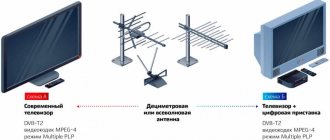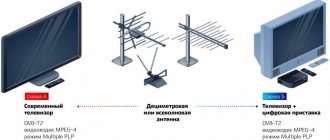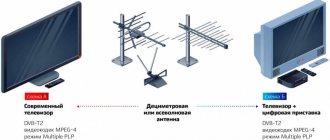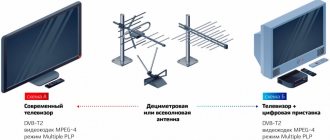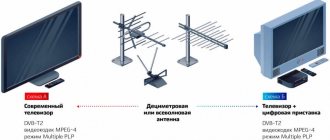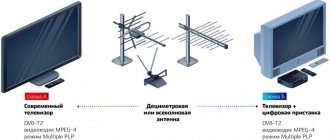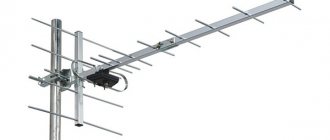What is needed to switch to digital TV in Kemerovo
If you use a TV built before 2013 or an older brand to watch TV programs, purchase a set-top box for it. Its price starts at 600 rubles. The receiver must function with the MPEG4 standard.
To operate the receiver you will need an outdoor or folding antenna. The TV tuner can be connected to a common house antenna. If such an antenna is missing, contact the management company.
In most houses in Kemerovo, the signal goes through a district repeater. After processing through the tuner, it is distributed via cable to residential buildings. In this case, subscribers do not need to use additional devices.
To watch digital TV, you need a TV built in 2013 or later. These devices can work with the DVB-T2 standard, which ensures the receipt and decoding of a digital signal in Russia. If there is such a television receiver, then to switch to digital broadcasting in Kemerovo it is enough to configure it through its menu.
Kuzbass switches to digital broadcasting
On April 15, 2019, the Kemerovo region will completely abandon the analogue television broadcasting standard and switch to digital quality. Residents of Kuzbass are already wondering what will await them after the designated date, whether sellers will profit from the sale of special electronic devices for converting broadcasts. Natalia Kukharskaya, head of the Kemerovo OFAS Russia, spoke about how the antimonopoly agency will monitor the situation in the region.
— Natalya Evgenievna, providing the country’s population with digital television broadcasting is one of the tasks of the federal target program “Development of television and radio broadcasting in the Russian Federation for 2009-2018.” Surely such a large-scale project will be extended over a long period of time?
— A special government commission has developed a plan for the phased shutdown of analogue broadcasting of mandatory public television channels in the constituent entities of the Russian Federation. In accordance with it, analogue broadcasting must completely cease in June 2021. The Kemerovo region is included in the second stage of shutdown. Thus, after April 15, a message about the need to switch to digital television reception will be posted on analogue television program frequencies. The screensaver will be broadcast for another week. Full information about the timing and shutdown plan is available on the official website of the Federal State Unitary Enterprise “Russian Television and Radio Broadcasting Network” (RTRS).
— Digital broadcasting is of better quality, will the population pay extra for such modernization?
— After switching off analogue broadcasting, residents of the Kemerovo region will receive a package of 20 free federal television channels: Channel One; "Russia 1"; "Russia 24"; "Russia-Culture"; NTV; Channel 5; "Match TV"; "Carousel"; "TV Center"; OTR; REN TV; TNT; "Home"; TV-3; STS; "Friday"; "Muz TV"; "Star"; "World"; "Saved". In this case, owners of analogue TV models will need to purchase special equipment for receiving a digital signal (digital set-top boxes that support the DVB-T2 standard). Digital TV does not require any additional equipment.
— What tasks are set for the Federal Antimonopoly Service in connection with the implementation of the target program?
— At a meeting on November 15, the Russian Government instructed the antimonopoly agency to organize price monitoring for user equipment for receiving digital television (set-top boxes, receivers) during the first half of 2021 in order to prevent unreasonable increases. FAS Russia centrally sent a request to federal chain stores and instructed its territorial bodies to find out the situation with prices for these set-top boxes in retail outlets in the region. On this instruction, our department developed an action plan, which, in addition to price monitoring itself, included on-site inspections of retail chains. We will monitor the situation to prevent attempts to “cash in” on citizens by sharply increasing user demand for set-top boxes.
— Have such attempts already been recorded?
— On December 12, 2021, the FAS Russia opened cases against DNS RETAIL LLC, MVM LLC, Eldorado LLC, and YULMART NJSC. The companies are charged with setting monopoly high prices for digital set-top boxes. A significant increase was established based on the results of price monitoring as part of a pilot project to introduce digital broadcasting in the Tver region, since this region made the transition to digital broadcasting on December 3. An unscheduled check of changes in prices for TV set-top boxes for the period from June to December 2021 showed that in the low price segment (up to 1000 rubles) the price increase ranges from 30% to 100%. In the high price segment (over 1000 rubles) the increase is from 5% to 83.9%. It is important to know that the FAS does not consider the reference to rush demand justified.
We have not yet identified any signs of violations in our region. Preliminarily, we can say that there are no companies in the region that occupy a dominant position in the market for the sale of these devices. Receivers are in demand both in hypermarkets and in specialized stores of household goods.
We will closely monitor the situation in the regional market for the sale of user equipment. I would like to remind you that violation of antimonopoly legislation is punishable by serious penalties.
cases of sharp, unjustified price increases for digital receivers in federal chain stores (DNS, M-Video, Eldorado, etc.) to the FAS Russia. Address: 125993, Moscow, st. Sadovaya-Kudrinskaya, 11, D-242, SP-3. E-mail With information about price increases by retail stores in the region, citizens have the right to contact the Kemerovo OFAS Russia. Address: st. Nogradskaya, 5, Kemerovo, 650000. E-mail
ID Contact according to the press service of the Kemerovo OFAS. Photo: google
#KuzbassIDK #TechnologiesIDK
What channels are available in Kemerovo
There are 3 multiplexes in Kemerovo. Two of them are standard and broadcast basic news and entertainment channels. The remaining multiplex is running in test mode. It includes sports channels, science channels, and nature channels.
On August 1 last year, the television tower in Ostankino began transmitting a signal in the DVB-T2 standard. The channel shows 7.5 hours of special information in UltraHD resolution. All residents of Kemerovo and the Kemerovo region have the opportunity to decode the signal.
The transition to digital television in the Kemerovo region will provide a rare opportunity to get rid of the old analogue format. Digital TV provides high-quality image and sound.
Search 82
The summer heat heats up the roofs of houses and the antennas installed on them for television reception. Temperature changes can theoretically affect the quality of TV signal reception. However, there are other, more obvious factors that can lead to interruptions in the TV signal. We tell you how to return your TV if it disappears.
Receiving antenna at its limit
In 2021, Russia completed the transition to digital terrestrial TV. Analogue broadcasting of federal television channels has ceased. Digital television is available to 100% of the country’s residents, of which 98.4% can receive an on-air television signal from a terrestrial television network, and direct satellite broadcasting is available to 1.6%. Digital television has made it possible for all residents of the country to receive 20 TV channels in excellent quality. The operation of RTRS transmitting stations is monitored by both specialists and automation, which sends a signal about the slightest deviations in the operation of any communication facility, even if this does not directly affect the operation of the equipment. For example, about an increase in temperature in the transmitter container. Therefore, the likelihood that the TV stopped showing due to a failure in the transmitting equipment is extremely low. For viewers, such glitches happen much more often. RTRS carefully analyzes the problems that arise among viewers. For this purpose, there is a “hotline”, the Viewer’s Account on the website watchdigital. RF, RTRS pages on social networks.
Based on the results of many years of monitoring requests, we can say that the main reason for the viewer’s signal loss is an incorrectly installed receiving antenna. The antenna that a person connects to his TV or set-top box. A little theory. In analog television, an incorrectly selected antenna produced a noisy picture on the TV. But the viewer understood that the broadcast was ongoing, the problem was on his side. With digital broadcasting, the usual analog interference is absent; the picture is either there or disappears altogether.
Periodic disappearance of the picture means that the antenna is catching the signal at the limit of its technical capabilities. Any change in reception conditions - rain, abnormal heat, blossoming leaves, even a passing car - slightly changes the signal strength, and the antenna is no longer enough. When overheating or cooling, the parameters of the metal change, and the contacts in the receiving antenna may be damaged. In analog, there would be noise on the screen; in digital, the image simply disappears. As a result, the viewer either sees a beautiful picture or doesn’t see it at all, and this confuses them, causing suspicions of transmission equipment failures. The practical conclusion from this theory is that it is necessary to select a receiving antenna that provides a margin of the level of the received signal, so that if conditions deteriorate, the signal is sufficient for reception. Its design must be durable and weather-resistant.
Most set-top boxes and TVs have a function that displays signal level and quality indicators on the screen. For reliable reception, the level indicators must be at least 60%, and the quality indicators must be 100%. This is the main rule for a successful reception.
Where is the antenna pointing?
Before purchasing an antenna, RTRS recommends that you first find out the distance to the nearest television tower. The location of the TV towers is indicated on the website at: map.rtrs.rf.
Depending on the distance, you need to select an antenna. The simplest are indoor antennas, they are easy to install, but they only work if the TV tower is in direct line of sight. If the tower is not visible from the window, you need an outdoor passive antenna (without a signal amplifier). It is installed on balconies, facades and roofs. Such an antenna reliably receives a signal at a distance of up to 20 km. For long distances, up to 30-50 km from the tower, you need an external antenna with an amplifier installed above the roof of the house.
Digital television is received only by UHF antennas. They usually look like a Christmas tree with its top facing the TV tower. VHF antennas, which are still left over from the days of analogue television, do not guarantee reliable reception of a digital signal. You can find out where the antenna should point using a compass, finding out the azimuth on the same website map.rtrs.rf, or by experiment. After connecting the antenna to the TV or set-top box using a cable, turn on the signal level and quality display mode on the TV or set-top box and rotate the antenna around the mast or bracket. The signal does not change immediately; after moving the antenna, you must wait a few seconds before the changes are displayed. Since the antenna may be on the roof, it is better to carry out this setup together, with an assistant seated in front of the TV. It is especially useful to experimentally adjust the direction of the antenna in the city.
The digital signal reflects well from buildings, and its level is often much higher when the antenna is facing the opposite building. A strong wind can spin the antenna, so if the TV stops showing after a hurricane or hail, you must first check how this event affected the outdoor antenna.
The eyes and ears of the TV
Knowing these features, it is easy to answer other questions about reception problems. For the same reasons - the receiving antenna is operating at the limit of its capabilities - only one multiplex can show.
Let us remind you that to broadcast 20 TV channels, each repeater uses two transmitters, each broadcasting 10 channels. Their power is the same, but the frequency channels are different, and some frequency is a little more consistent with the characteristics of the receiving antenna. A similar problem occurs in remote areas where the signal strength is weak. An outdoor antenna with an amplifier mounted on a high mast should work here. But placing a powerful antenna near a station is like shouting in your ear; the signal will disappear. But such errors, according to the statistics of requests, are extremely rare.
The antenna circuit also includes the cable that runs from the antenna to the TV. If it is poorly soldered to the plug, damaged, pinched, it extinguishes the signal. One of the viewers complained that his TV stopped showing in the morning. It turned out that dew got into the damaged cable in the morning, and it dried out in the afternoon. The cable resistance should be 75 ohms. This is usually written on its braid, which looks like a thick wire - about 1 cm in diameter. The antenna is the eyes and ears of the TV. Only with it will the TV delight you with a beautiful picture.
Statistics show that viewers have already mastered the features of digital reception and are confidently switching channels. If you don’t have the time or desire to understand this, on the same website map.rtrs.rf you can find contacts of the nearest antenna service and entrust the matter to professionals. By the way, antenna services can add their contacts to the site to indicate their willingness to help viewers.
homyak:
10/06/2014 at 20:35
Indicative figure
10/02/2014 Almost the entire Kuzbass can now watch modern quality television.
Non-analog picture
It became possible to receive a picture that is much better than analogue after the commissioning of 18 digital broadcasting facilities in our region. Moreover, all-Russian TV channels will become available in any, even the most remote corner of Kuzbass, and everywhere the image quality will be of high quality.
You can even receive an encoded over-the-air signal on an old analog TV - all you need to do is purchase a special digital set-top box.
— Now there are about two hundred different types of such consoles on the market. The cheapest of them costs about 800 rubles. In general, since 2012, only TV sets have been sold in our country that are equipped with all the necessary equipment for receiving a digital signal,” explained Andrei Romanchenko, General Director of the Russian Television and Radio Broadcasting Network (RTRS).
Program broadcasting
According to the federal program for the development of television and radio broadcasting, it is planned to build about 40 digital broadcasting facilities in Kuzbass. 287 million budget rubles and 97.5 million rubles of RTRS’s own funds have been allocated for this.
Let us remember that the program was approved by the Russian government in 2009. It has been implemented for 5 years now. And by 2015, almost 5 thousand digital broadcasting facilities of 1 multiplex (that is, combined into a single package of channels) are planned to be launched throughout the country. 1 multiplex (RTRS-1) includes 10 all-Russian and public digital television channels, such as Channel One, Russia-1, NTV and so on.
After zone 1 of the multiplex covers more than 98.3% of the country's population, broadcasting of multiplex 2 (RTRS-2) will be launched. It includes 10 more all-Russian channels (for example, such as “Sport Plus”).
At the moment, 2977 objects have already been commissioned for digital signal distribution. Another 1,479 are under construction. By the end of the year, another 919 objects will need to be completed.
"Batch" coverage
Upon completion of the implementation of the federal target program throughout Russia, both the 1st and 2nd multiplexes should reach 98.3% of the audience.
Now for 1 package this figure is 81%, but by the end of this year the share will increase to 90%. If you look specifically at the channels, today 96.4% of Russians have the opportunity to watch “Channel One” digitally, the “Russia-1” channel – 95%, NTV – 66.6%.
For package 2, the coverage is less, only 41%. It is currently operating only in 63 constituent entities of the Federation, including in the Kemerovo region since May.
At the same time, there are requirements for the number of spectators in the regions. Thus, population coverage in each should be at least 95%.
In our region, now almost 82% of the population can watch 10 channels from 1 RTRS package.
By October next year, after the introduction of two more facilities, the number of Kuzbass residents who will have the opportunity to watch digital television will reach 96.2%.
— 10 projects have already been completed for multiplex 2 in Kuzbass. For now, 6 transmitters will operate: in Anzhero-Sudzhensk, Kemerovo, Leninsk-Kuznetsky, Novokuznetsk, Kiselevsk, Mezhdurechensk, and the coverage will be 1845 thousand residents, or 66.76% of the region’s population. Work on package 2 will continue until 2021,” noted Andrey Romanchenko.
There is also a 3rd package of channels: RTRS-3.
Initially, it was proposed to give it exclusively to regional television companies. That is, so that only Kuzbass channels broadcast in the Kemerovo region, and only Altai channels in Altai.
However, there was a problem with filling out the package, since in some regions television journalism is poorly developed and there are practically no local channels except VGTRK. Therefore, it was decided to distribute the channels in package 3 as follows: 1 to be given to the regional channel VGTRK, 2 to regional television and radio companies, and the remaining 7 positions to be filled with federal channels.
Evgeny FEDOTOV. NEWSPAPER "KUZBASS", COMPANY
Answer
